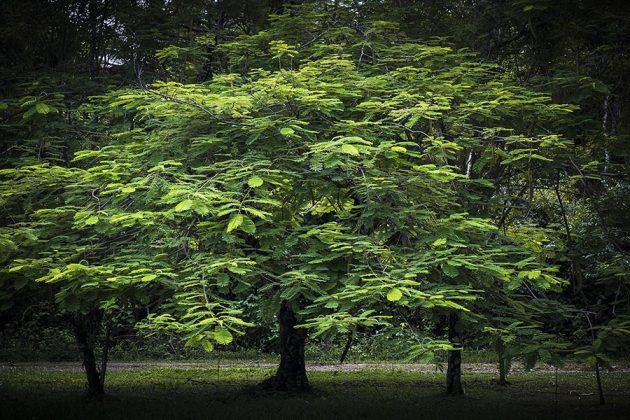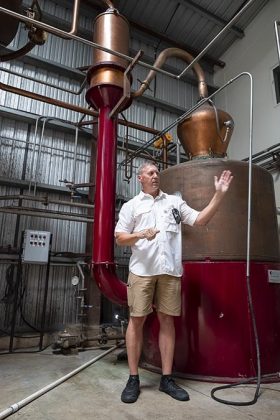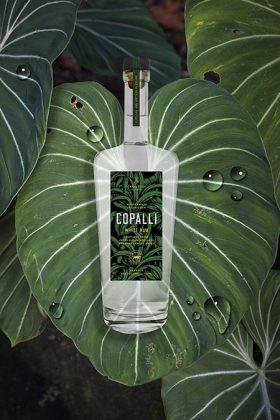These days, environmental responsibility is no longer a choice. For many distilleries, it’s a necessity. Implementing sustainability practices requires careful thought and design around the environmental pitfalls present throughout the life cycle of distillation: farming and harvesting, the source of energy and consumption, water and waste management, bottling and labeling and more.
It takes patience, passion and commitment. That is how Copal Tree Distillery is doing it, right in the jungle of Belize, on lands with a rich history dating back to the Classic Mayan Period when Mayans still used the Rio Grande River to transport goods.
“Environmental principles should be a core value for all tiers in the industry, and we believe it is.” Nick Anderson, CEO of Copalli Spirits, mentioned. “That said, Copalli is uniquely positioned to go much further than most rum producers because these principles guided our business model from its inception. Since everything was built from the ground up, we were able to ensure the farm is organically managed, the harvesting process is by hand and not machine, the distillery utilizes the sugarcane stalks to run its boilers, the leftover ash is used to fertilize our crops and water is captured naturally in the Belizean rain forest. The distillery, through its efficient use of the raw inputs and the resultant biomass from the distillation process, produces much of its own energy.”
Back in 2005, Todd Robinson, a marine conservationist, started buying the property of the surrounding rain forest and partnered with Anya Fernald of Belcampo. Contributing to the health of the environment and the local community, today over 20,000 acres of land is the home to a luxury eco-lodge, a 3000-acre organic farm, and the recent addition of Copal Tree Distillery.
While still young in the world of distilleries, Copal Tree Distillery takes a very thoughtful approach to both their products and sustainability practices.
The distillery currently has two rum products on the market: White Rum and Barrel Rested Rum. They are made from only three natural components: heirloom sugarcane juice, canopy water straight from the rain forest and yeast.
For those who are new to the rum distillation, sugar cane juice is mostly used in the production of rhum agricole and clairin, which contributes to the grassiness with a hint of sweetness in the rum profile. On the other hand, Belize’s history as a British colony has led to it being known for fuller body rum as a result of using pot stills.
Ed Tiedge, the master distiller and the president at Copal Tree, took the best of both worlds. To retain its freshness, sugarcane juice is pressed within two hours of harvesting at the Copal Tree Distillery, instead of the common practice of 12–24 hours. The white rum uses a combination of 75% column stills and 25% pot stills, then rests in stainless steel for six months.
This combination results in a very approachable rum but packed with flavors such as fruit notes with a hint of grassiness. It is a great introduction to those who are new to big funky and grassy characters such as rhum agricole and clairin. On the flip side, the barrel-rested rum is 100% pot still and then rests in an ex-bourbon cask. It is packed with flavor! While the white rum is very cocktail friendly, it may not stand out in drinks that call for strong and intense flavor. This is where a 100% pot still rum, whether aged or unaged, comes into play.
Another common practice for white rum is charcoal filtration, which is used for removing harsh flavors to smooth out rum. However, the more you process your distillation, the less character is left in the bottle. Because Copalli rum is using all of the purest ingredients, they have decided not to bother with this process at all.
Copalli takes a zero-impact production practice, not an easy task. There are many areas of production to cover, and being thoughtful about each stage has required Copalli to spend four years designing solutions, which they continue to improve on.
First, Copalli Rum is organic certified. Organic certification is a process that requires detailed tracking of ingredients and processes. A field needs to have been free of chemical fertilizers and pest control for 5 years to begin the certification process. Once that basic requirement has been met, a distillery needs to document every step, from the organic fertilizer used, the harvest, transportation by the distillery, crushing, fermenting, distilling, blending and bottling. You need to be prepared to identify what field a particular bottle of rum was sourced from. Even cleaning the equipment is described and recorded. Once all these processes and procedures are in place, an inspector will come and do an on-site evaluation. If you pass the inspection, then you will be issued a certificate as an organic producer. Re-inspection occurs every year to keep your certification. For Copal Tree, the process isn’t that onerous because they only use organic products and tracking the process from field to bottle is just good distillery practice.
A typical distillery needs two sources of energy to operate: thermal and electrical. At Copal Tree, thermal energy comes from the biomass steam boiler and is fueled by the cane fibers after the juice has been exacted. This steam energy is used for running the stills, making hot water for cleaning and sanitizing tanks and even as the energy source for the cooling system that regulates the temperature of the fermentation tanks. The electrical energy runs the pumps, lights, computers and other electrical components. When not enough, Copal Tree Distillery does have to purchase additional energy from the electrical utility as the distillery is still very young. They hope to be able to make their own electricity in the future as they grow.
“At Copalli, every sugarcane is cut by hand during the harvest season instead of the more common practice of using cane fires,” says Richard Brinckmann, Copal Tree farm manager. “Cane fire is essentially a flash fire to burn off dried leaves in the field. Because of the high water content in sugar cane, the cane itself and sugar content are intact during the fire. However, this fire generates smoke that is bad for the local community, not to mention the carbon dioxide it releases. By hand cut only, a considerable amount of green materials are left in the field (not burnt) as mulch and fertilizer too. The farm is also free of pesticides, and we use a little chicken manure from the Belizean farmers to enhance the fertilization.”
Copalli rum is using pure canopy water collected from the rain forest. After distillation, the sugarcane leaves a lot of liquid behind, which is called vinasse. Copalli does two things with it. First, they use it as liquid fertilizer on Copal Tree’s farm because of its rich nutrients. Second, they use catchment ponds to neutralize the dirty water through probiotics. What comes from the land goes back to the land.
Other than vinasse mentioned above, the other waste is the sugarcane fiber, which is used to fuel the boiler. The ash from the boiler provides additional nutrients and helps maintain a favorable pH in the soil.
When it comes to bottling and labeling, one of the biggest problems the industry is facing is how to minimize waste from all those glass bottles and cardboard boxes that get shipped around the world. If we are going to be truly sustainable, we must assess all of the supplies as well. Copal Tree Distillery is on the lookout for solutions in this area. In addition, they hope to get big enough one day to produce their own electricity and keep the energy and carbon cycle local.
Last but not least, Copalli contributes to the local community. It employs over 130 people, making them the largest employer in Southern Belize. It also spends up to $50,000 on education grants to help local girls go to high school.
“Belize is a very small country,” says Destiny Wagner, a native Belezian and social justice advocate who grew up near Copalli. She was raised in Punta Gorda, and later attended college in New York. “However, we are constantly progressing,” she says. “Back in the day women were expected to get married early and have kids while being forced to discontinue their education. Although some households still carry that mindset, we are breaking generational curses at a steady pace. For example, we have two women in the House of Representatives.”
These are just a few of the steps that Copal Tree is taking for a more sustainable future, by improving every aspect possible. To leave a habitable world for new generations to come, whether you are a distiller or a consumer, perhaps the first question to ask is: what is your in rum?












